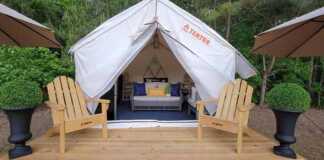You can find some of the most stunning scenery in Nevada in the state’s national parks. Nevada has two national parks, a national monument, a national recreation area, three national historic trails and 13 state parks. The landscapes are varied and eye-catching, from snow-capped mountains and deep canyons to alpine lakes and unique geological features. Nevada’s national parks and other natural areas also offer plenty of outdoor activities, such as hiking, camping and stargazing. Here’s a mini-guide to the national parks in Nevada.
Contents
Nevada National Parks Guide
1- Death Valley National Park
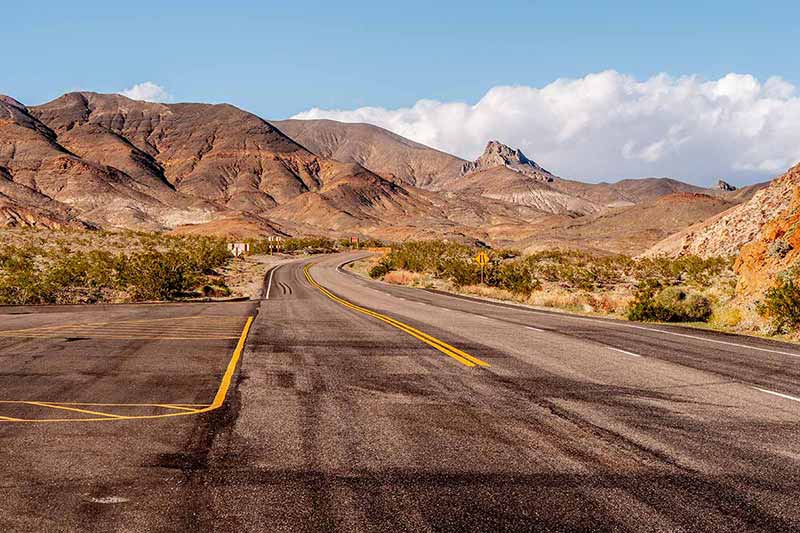
Death Valley is one of the larger national parks managed by the US National Park Service, with 3 million acres (1.21 million ha) straddling California and Nevada.
This spectacular national park is a landscape of dunes, vibrant coloured rocks and mountains, towering peaks and unique geological features.
It’s the hottest place on Earth, recording 56.7°C (134°F) in 1913 and the driest place on the North American continent.
Telescope Peak in the Panamint Mountains, at 11,049 feet (3368 m) above sea level, is the park’s highest peak and the tallest mountain in the range.
Surprisingly, this peak is only 15 miles (24 km) from Badwater Basin, which, at 282 feet (86 m) below sea level, is the USA’s lowest point.
The national park may appear dry and uninhabitable, covering desert landscapes in the Mojave and Great Basin deserts, yet it is home to a rich ecosystem.
Wildlife in this national park includes bighorn sheep, kangaroo rat, chuckwalla, sidewinder rattlesnake, coyote, jackrabbit, desert tortoise, mountain lion, desert cottontail and rosy boa.
At lower elevations, the flora includes desert holly, creosote bush, mesquite, black brush, shad scale, limber pine, bristlecone pine, cactus, and Joshua tree.
The salt pan has no plants, and the lower slopes and valley floor have very little vegetation, but plants are usually abundant wherever there is water.
Things To Do In Death Valley National Park
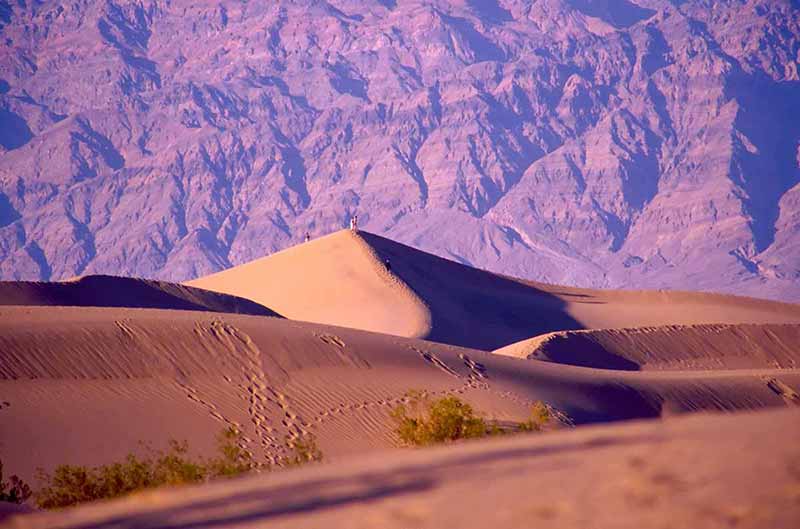
Given the park’s size, there is much to explore, and iconic places are Zabriskie Point, Mesquite Flat Sand Dunes, Artist’s Palette, Badwater Basin, Ubehebe Crater and a variety of other unique geological landmarks.
Although most of these places are in the California section of the park, the Nevada side also has a few attractions for visitors to enjoy.
Devils Hole is a water-filled 500 feet (152 m) deep limestone cavern in the Amargosa Valley that is still a mystery to scientists, who are still trying to determine how deep it is or its origin.
The ghost town of Rhyolite and the remarkable Goldwell Open Air Museum are also located just a few miles from the east entrance in Beatty.
How To Get To Death Valley National Park
The nearest city is Beatty, Nevada, and the most direct route from there is through Pahrump, Nevada, and California Highway 190, which takes around two hours.
The park is also accessible from Beatty through Route 374.
Las Vegas McCarren Airport, about 120 miles (161 km) away, is the nearest major airport to the park.
If you love exploring national parks, you might like to read:
- Wyoming National Parks Guide
- Nevada National Parks Guide
- Michigan National Parks Guide
- 5 Maine National Parks
- New Hampshire National Parks Guide
- 25 National Parks in Canada
- 17 National Parks in Argentina
- Tasmania National Parks
- 20 National Parks in Mexico
- 18 New Mexico National Parks
- 18 National Parks in Massachusetts
- 17 Colorado National Parks
- 4 Indiana National Parks
- 5 Nebraska National Parks
- 30 Virginia National Parks
- 9 New Jersey National Parks
- 8 National Parks in Arkansas
- 8 Alaska National Parks
- 13 Tennessee National Parks
- 6 National Parks in Louisiana
- 5 Illinois National Parks
- 7 National Parks in Oklahoma
- 7 National Parks in South Dakota
- 12 Alabama National Parks
- 5 North Dakota National Parks
- 8 National Parks in West Virginia
- 20 National Parks in Arizona
- 11 National Parks In Florida
- 8 Hawaii National Parks
- 6 National Parks In Idaho
- Texas National Parks Guide
- 9 California National Parks
- 11 National Parks In Georgia
- 7 National Parks In Missouri
- 5 National Parks in Minnesota
- 7 National Parks In Kentucky
- 8 National Parks In Montana
- 15 National Parks In Washington State
- 8 South Carolina National Parks
- 12 North Carolina National Parks
- 4 Wisconsin National Parks
- 20 National Parks In India
- 11 Oregon National Parks
- 5 Connecticut National Parks
- 27 National Parks In New York State
- 4 Iowa National Parks
- Yosemite National Park
- Zion National Park
- 21 National Parks in Pennsylvania
- 9 National Parks in Mississippi
- 5 National Parks in Rhode Island
- 9 National Parks in Taiwan
- 20 East Coast National Parks
- Guide To Winter in Yellowstone National Park
2- Great Basin National Park
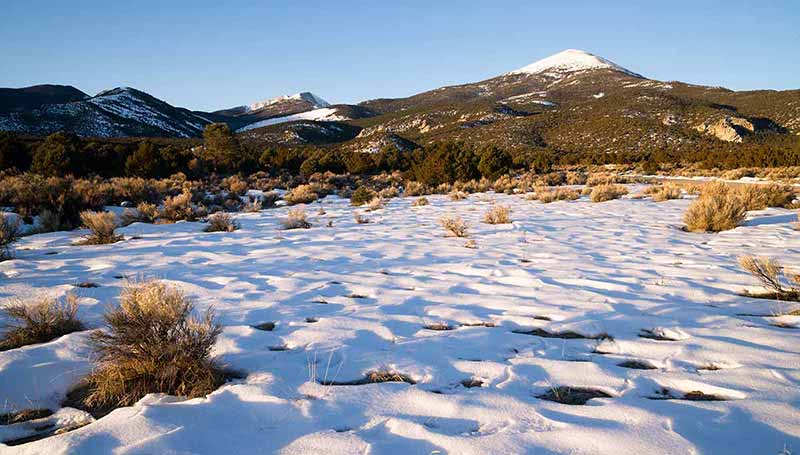
Great Basin National Park lies in the shadow of the 13,064 feet (3,984 m) Wheeler Peak.
The park is geologically diverse and covers an area of 77,180 acres (31,233 ha), with cascading mountain streams, alpine lakes, the state’s only glacier and a massive cave system.
Great Basin National Park’s habitats support a range of wildlife, from bobcats and mountain lions to beavers and bighorn sheep.
The Ringtail Cat (Bassariscus astutus), Sagebrush Vole (Lagurus curtatus) and Yellow-bellied Marmot (Marmota flaviventris) are three unusual mammals to look out for.
This Nevada national park is also home to birds like the golden eagle, red-tailed hawk, Stellar’s jays, Clark’s nutcrackers, Cooper’s hawk, western meadowlark and barn swallow.
The Bonneville cutthroat trout is a trout species native to the Great Basin National Park, but other trout species exist in the national park too.
Despite the arid climate, 800 plant species like sagebrush, blackbrush, shadscale, Mormon tea, joint fir, saltbush, iodinebrush and greasewood, are able to cope with the desert conditions.
Limber pines, juniper, pinyon trees and bristlecone pines are among the other trees in the park.
The bristlecone pine trees in this national park in Nevada are among the world’s oldest trees, with the ability to live for up to 4000 years or more, even in harsh conditions.
Things To Do In Great Basin National Park
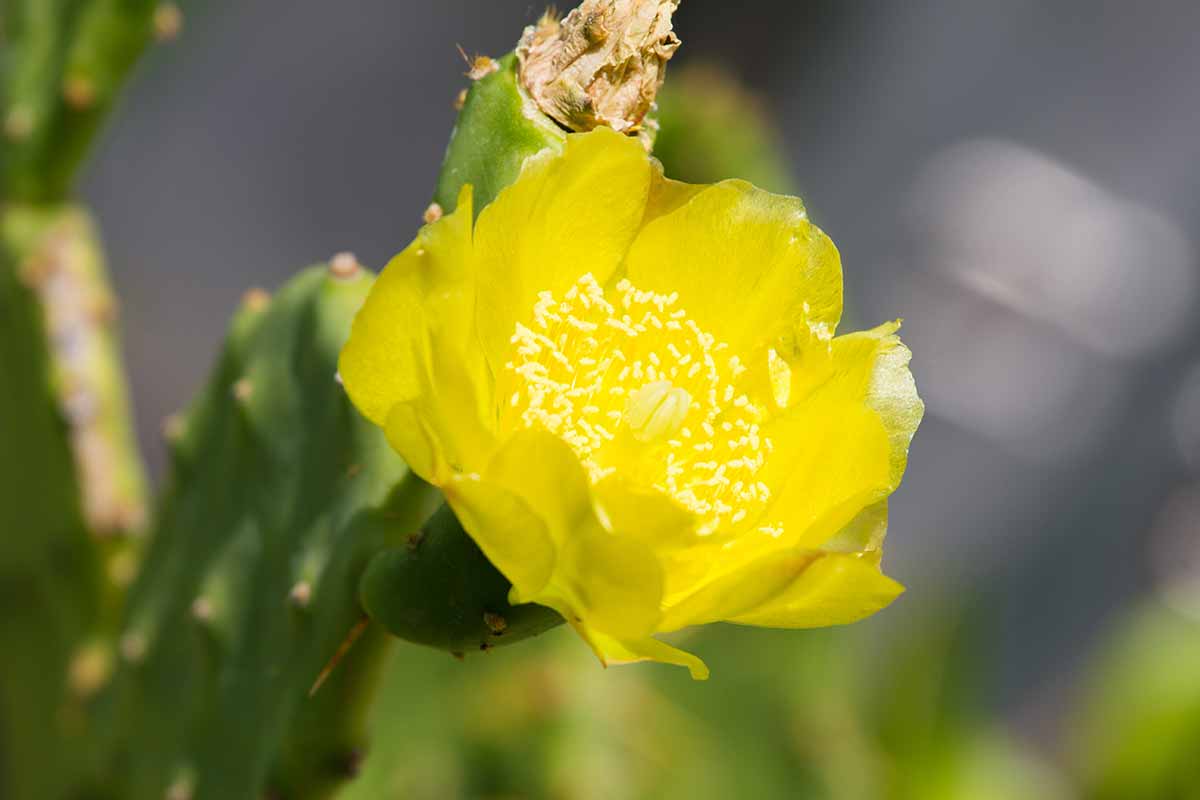
Explore Lehman Caves
There are several caves in Great Basin National Park, but only seven are open to the public.
Lehman Caves is the most popular, as this cave system has a spectacular array of stalactites, stalagmites and rare cave formations known as helictites.
Explore Baker Archaeological Site
Excavated by Brigham Young University’s Office of Public Archaeology between 1991 and 1994, the site contains the ruins of a Fremont Indian village.
This 11th-century village offers a fascinating look into Fremont culture and is located just outside the Great Basin National Park.
Hiking
60 miles (96 km) of hiking trails of varying difficulty levels make this Nevada national park a great place to explore.
There are easy to moderate trails like Mountain View Nature Trail, Grey Cliffs and Bald Mountain.
Several high peak trails – such as the Alpine Lakes Loop, the Wheeler Peak Summit Trail and the Bristlecone Interpretive Trail – start at Wheeler Peak Campground.
The latter is one of the best trails for viewing ancient bristlecone pines.
Camping
Five campgrounds offer services in the Great Basin National Park, but only one is open all year round.
Most campgrounds can accommodate eight and come with tent pads, picnic tables, vault toilets and campfire grills.
Aside from the developed campgrounds, there’s the primitive Snake Creek campgrounds on Snake Creek Road.
Stargazing
Great Basin National Park has dark night sky that is fantastic for stargazing and the best time to do it is in summer.
The Mather Overlook is a perfect spot to stare at the stars as it has a broad view of the horizon. Stargazing is also possible at the Baker Archaeological Site and the Ranch Interpretive Site.
Other activities in the park include trout fishing, wildlife viewing, rock climbing and cross-country skiing.
How To Get To Great Basin National Park
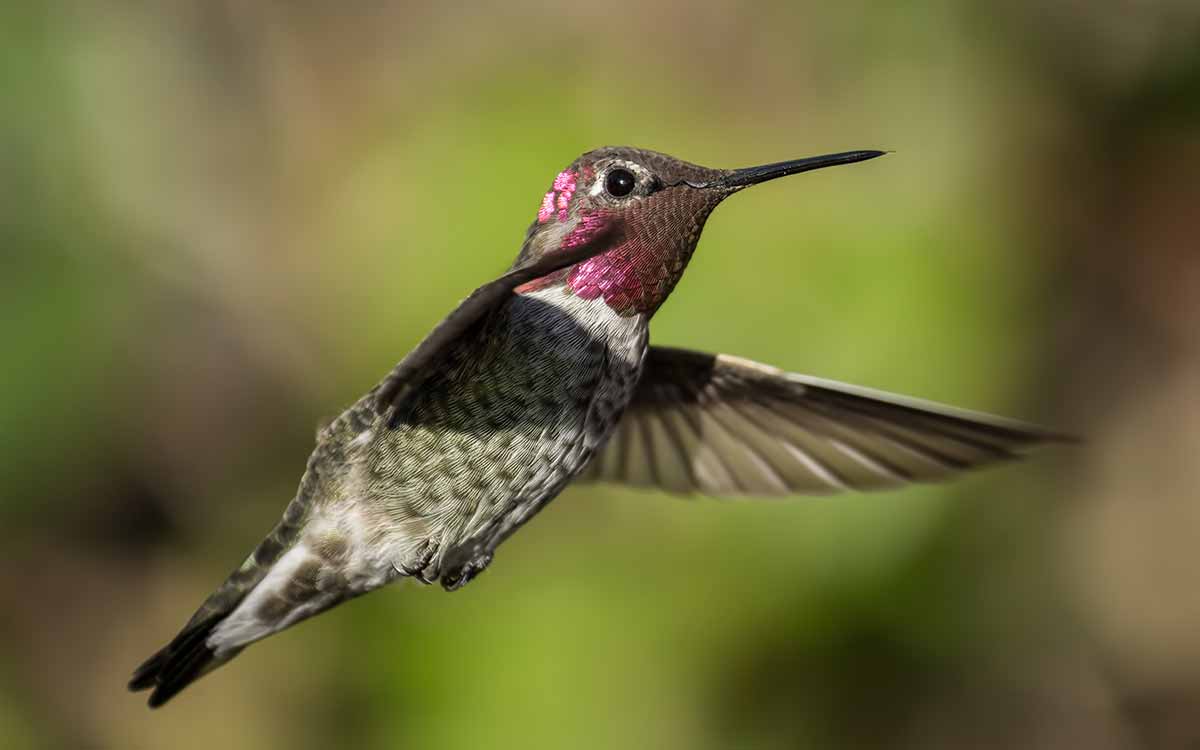
The town of Baker, Nevada, is five miles (8 km) east of the park’s main entrance, and the city Ely is about a 90-minute drive away.
The closest airport to Great Basin National Park is in Cedar City, Utah, 142 miles (228 km) away while there are major airports in Salt Lake City, 234 miles (376 km) away, and Las Vegas, 286 miles (460 km) away.
3- Lake Mead National Recreation Area
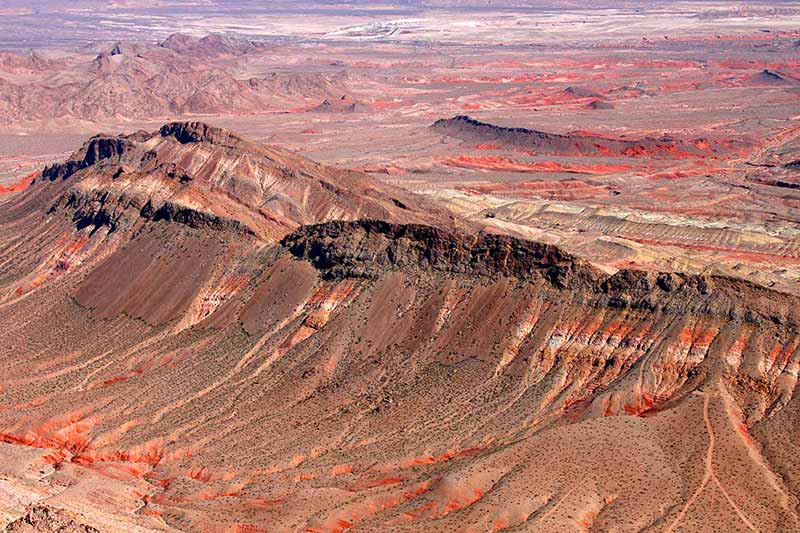
Lake Mead National Recreation Area straddles Nevada and Arizona.
Covering 1.5 million square miles (3,885,000 square km), it was the first national recreation area in the United States and the largest in the country.
This region includes Lake Mead and Lake Mojave, canyons, mountains, desert, valleys and marinas.
The area was named after Lake Mead, created when the Hoover Dam was built across the Colorado River.
Lake Mead is the USA’s largest reservoir, stretching 110 miles (177 km) across Nevada and Arizona.
Millions of visitors flock to the lake to enjoy boating, fishing, swimming and other water sports.
Although the lake is the area’s main attraction, there are other opportunities to appreciate the beauty of the surrounding Mojave Desert.
Numerous hiking trails provide views of the park’s exposed geology and a diverse array of unique plants and animals.
The beautiful desert region is home to flowering plants, trees, cacti and shrubs despite receiving less than six inches (15 cm) of rain annually.
There’s an incredible variety of wildlife, including 41 reptile species, 12 amphibian species, over 240 bird species and a large population of mammals like desert bighorn sheep, bats, beavers, coyotes and rabbits.
The area is also home to an abundance of fish, including the endangered Razorback Sucker.
Things To Do In Lake Mead National Recreation Area
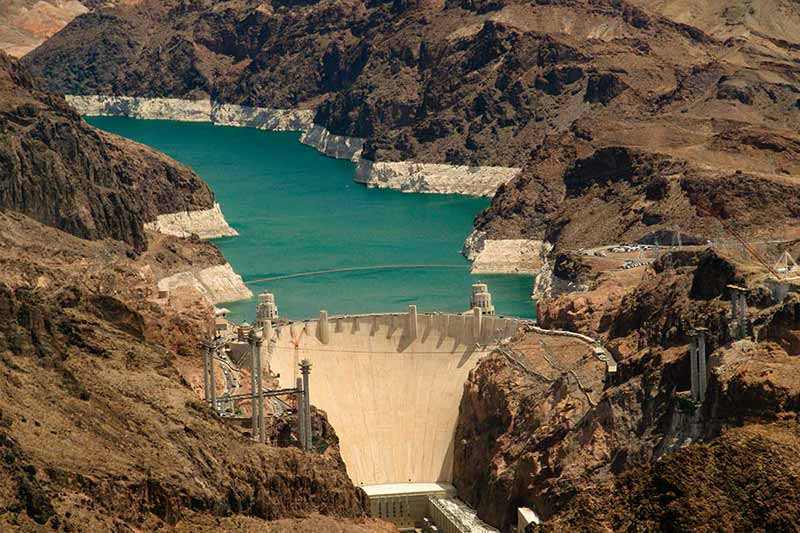
Water Sports
With over 290 square miles of waterway to navigate, you can rent a speed boat, pontoon, fishing boat or houseboat and enjoy the water.
Another great way to enjoy the water is renting a kayak, canoe or paddleboard and paddling along the smooth, calm waters of the lakes, surrounded by colourful mountains.
Fishing
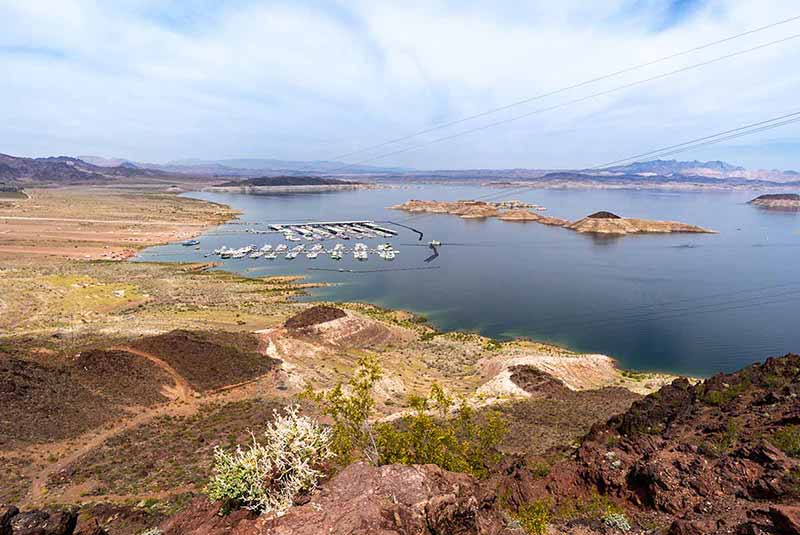
Fishing is a popular activity at Lake Mead National Recreation Area.
The most popular fish include rainbow trout, striped bass, catfish, sunfish, largemouth bass, smallmouth bass and crappie.
Lake Mead has also become well-known for its striped bass, with a few catches weighing 40 pounds (18 kg).
Hiking
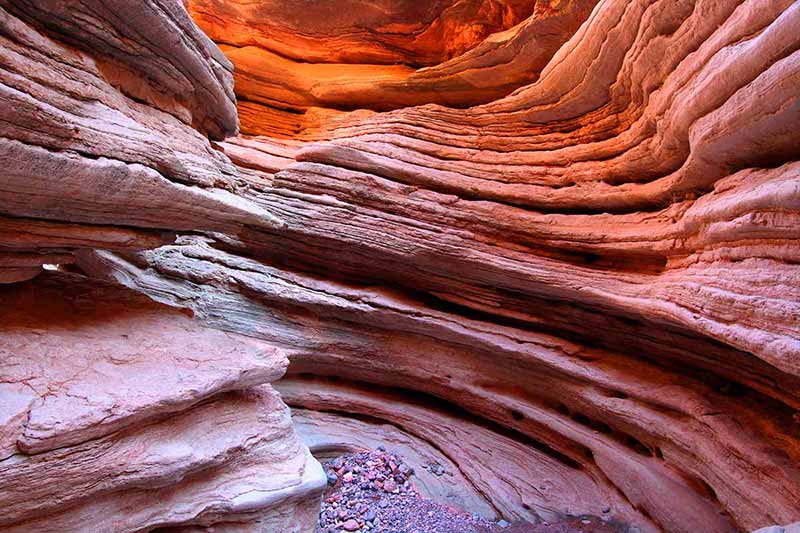
Lake Mead and Lake Mojave are the main attractions for visitors and there are also excellent hiking trails to explore the area’s diverse ecosystems.
There are 15 trails to choose from, including two that offer panoramic views of the Boulder Basin and the 34-mile (54 km) River Mountains Loop.
Camping
Lake Mead National Recreation Area is well set up for camping, with over 900 camping and RV sites in 15 different locations, offering visitors a wide range of amenities and services.
Tents, RVs and trailers are all welcome and there are restrooms, running water, dump stations, barbecues and picnic tables.
Other activities include scuba diving, swimming, biking, camping, horseback riding, photography and hunting.
How To Get To Lake Mead National Recreation Area
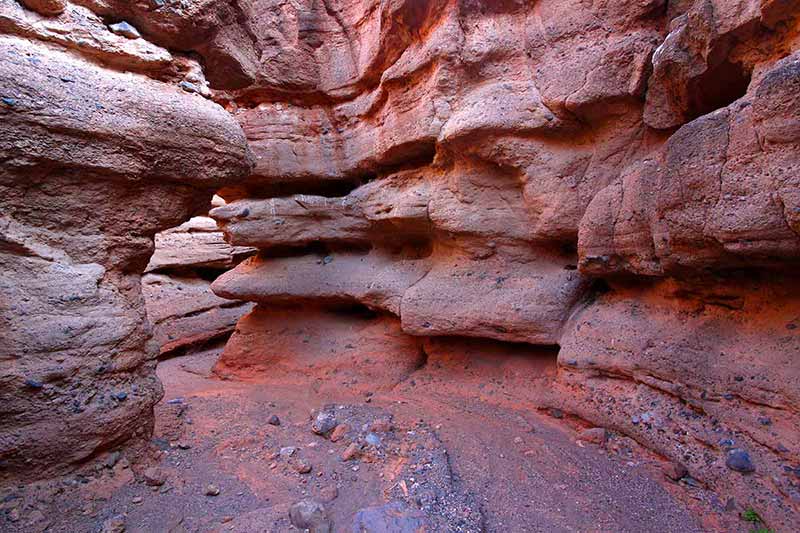
The closest city is Boulder City, Nevada, and the Lake Mead Visitor Center is four miles (6 km) from the city on US Highway 93.
The Las Vegas Strip and McCarran International Airport are only 25 miles (40 km) away.
Smaller airports in the area are North Las Vegas Airport and Laughlin/Bullhead City Airport, both about 78 miles (126 km) from Boulder City but just south of Lake Mead National Recreation Area.
4- Tule Springs Fossil Beds National Monument
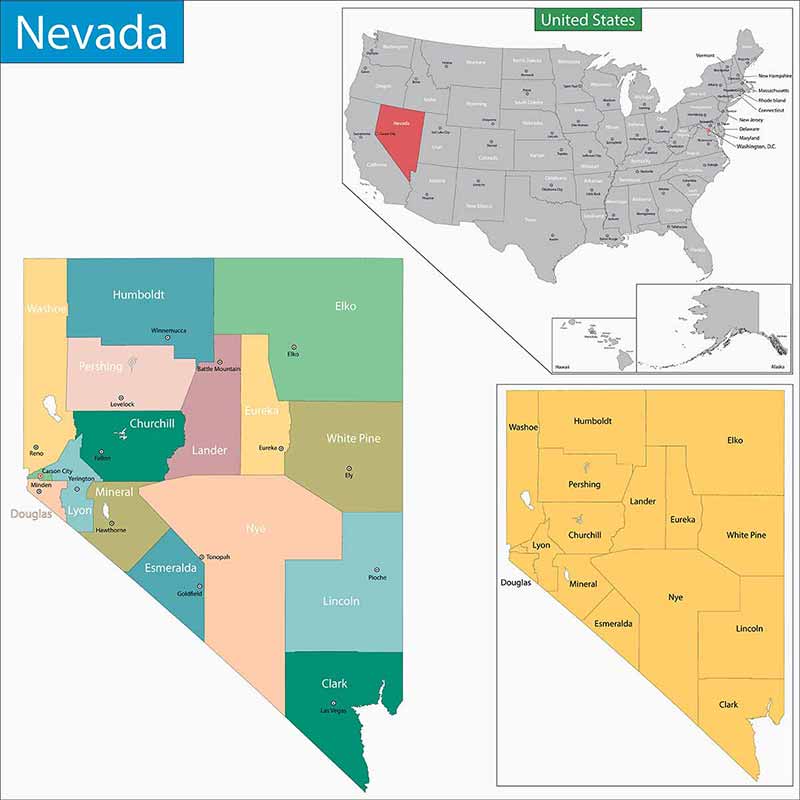
Tule Springs National Monument is a natural wonderland with a fascinating geologic history, located just 20 minutes north of Las Vegas.
It covers approximately 22,600 acres (91 square km) and stretches from north Aliante and Centennial Hills along US Highway 95 to Creech Air Force Base.
This monument was established in 2014 and is one of the world’s best records of Ice Age fossils.
It’s the first National Park Service monument dedicated solely to Ice Age fossil preservation, public education and scientific research.
Thousands of years of paleontological history, including the last two Ice Ages, are protected here.
Extinct mammoths, American lions, large camels, extinct horses, dire wolves, ancient bison, giant sloths and other animals have been discovered entombed in the rocks.
This monument is unique and what makes it so fascinating is the sheer number of fossils and species discovered.
You can also find wildlife, such as bighorn sheep, coyotes, bobcats and mule deer.
A few reptiles, including snakes, lizards, and desert tortoises, can also be found here, though they are rarely seen.
Common birds include northern mockingbirds, house finches, hawks and hummingbirds.
The plants that dominate the landscape are creosote bush, yucca, and white bursage.
Shadscale saltbush covers a large portion of the northwest end of the park.
Other shrubs found here include Nevada jointfir, desert globemallow, beavertail cactus, and matchweed, while Las Vegas bear poppy, buckwheat and desert princesplume are some of the rare plants.
Things To See And Do At Tule Springs Fossil Beds National Monument
The Big Dig trenches area, built in 1962, is a hotspot for fossil discovery.
There are no developed recreational opportunities, but popular activities include hiking, photography and exploring this prehistoric landscape.
Although no campgrounds exist in the park, there are several in the surrounding area.
How To Get To Tule Springs Fossil Beds National Monument
Las Vegas International Airport is the closest airport. Visitors can get to the park by driving from the Las Vegas Strip to Elkhorn and Aliante Parkway in North Las Vegas.
The Regional Transportation Commission also provides public transportation from Las Vegas to the park.
For more about Nevada, read:
Plan Your Trip

Rent A Car – Find the best car rental rates at Discover Cars. They compare car hire companies to provide you with the best deal right now.

Find A Hotel – If you’re curious about this article and are looking for somewhere to stay, take a look at these amazing hotels.
